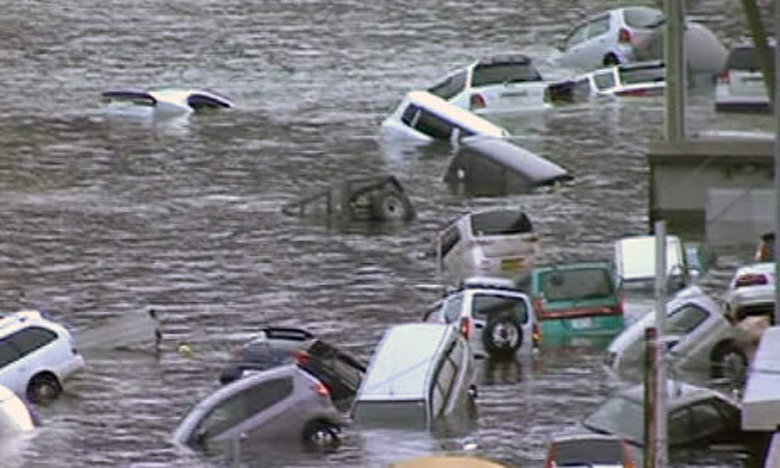Introduction
A tsunami is one of the dangerous hazards, as it usually takes away the lives of many individuals. Additionally, tsunamis happen rather fast and often, and the researchers still lack knowledge in the prediction and announcements of the natural hazards in time. Despite the quick improvement of technology and political changes, tsunamis still have a tendency to be disturbing since not many people can react rapidly to the sudden alert of danger.
Nonetheless, the primary goal of this paper is to evaluate and discuss the tsunami, which took place in 2011, in Tohoku. This devastating tsunami occurred after the strong earthquake with a magnitude of 9.0 (Poster of the Great Tohoku Earthquake 2012). In this instance, Figure 1 presents the devastating results of the tsunami.
It could be seen in the picture that the heavy cars are floating in the water, and the water occupies the whole coastline of the east of Japan (Vehicles are washed away by tsunami 2011). Nonetheless, the image does not present over-destructions, as the building was also dramatically damaged by the tsunami.

Analysis
In this instance, the geological origin of the tsunami has to be discussed due to the fact that it plays a significant role in predicting the presence of a tsunami in the future. In turn, the types of tsunamis also have to be evaluated, as they have different levels of destructive power. All of these aspects will be also assessed in the context of Tohoku’s tsunami in 2011. In the end, the conclusions are drawn to determine the level of danger of this natural hazard to the existence of humankind. These aspects will help understand the nature of tsunamis and determine their impact on the existence of humankind.
Firstly, the geological origin of the tsunami has to be discussed to determine the potential reasons for tsunami occurrence. One of the reasons is the volcanic eruption. A release of magma happens due to the high density of magma and other gasses under the Earth’s crust (Masters 2012). It remains evident that, in this case, significant volumes of debris crash into the ocean and cause the presence of strong waves in the ocean. In turn, the debris causes the water to move towards the shore with the high speed and make the tsunamis.
Nonetheless, another primary cause of the tsunami is the earthquake. In this instance, the earthquake occurs due to the release of the pressure under the crust of the Earth, and the lithospheric plates slowly move (Levin & Nosov 2009). In this case, the epicenter of the earthquake is also the center of the tsunami since the waves start the slow movement. Speaking of the case of Tohoku in 2011, it remains evident that the primary reason is the earthquake, as its magnitude was 9.0. It could be said that this magnitude is enough to create a rapid and destructive tsunami, which is able to cause significant damage to Japan and other countries. In the end, all kinds of tsunamis are dangerous due to their rapid movement.
It remains apparent that different kinds of tsunamis have a tendency to be present. In this case, regional, local, and distant are the main types of tsunamis (Mercado-Irizarry & Liu 2006). The local tsunamis occur rather fast, and the population is not able to react fast to the danger. Additionally, the waves are rather fast, and the government is not able to announce the existence of danger to the population. In turn, regional and distant tsunamis are less dangerous, as their travel is longer (Mercado-Irizarry & Liu 2006). It could be said that, in this case, the population of the country can be evacuated, as more time is available. Nonetheless, despite having longer travel distance, these types of tsunamis are rather dangerous and destructive due to the high power. Speaking of the case of Tohoku, the tsunami had a short traveling distance, as the earthquake occurred near the coast of Japan. In this instance, the destructive power was high, as the population was not able to react fast to the accident.
Conclusion
In the end, tsunamis are one of the most dangerous hazards since they are still hard to predict. They tend to appear fast, and it is hardly possible to get the population evacuated on time. Its destructive power was displayed with the assistance of the tsunami in Tohoku. Nonetheless, the two primary reasons for their appearance are volcanic eruptions and earthquakes. This knowledge helps reduce the number of victims from natural hazards. However, it is still one of the most powerful hazards and causes high danger to the existence of humankind. Additionally, some of the animal species might disappear from the surface of the planet due to the occurrence of the tsunamis. It could be said that more research regarding the tsunamis has to be conducted to lessen the dangerous effects of these hazards and minimize the number of victims.
Reference List
Levin, B & Nosov, M 2009, Physics of tsunamis, Springer Science + Business Media B.V., New York.
Masters, N 2012, Volcanic eruptions, Cherry Lake Publishing, North Mankato.
Mercado-Irizarry, A & Liu, P 2006, Caribbean tsunami hazard, World Scientific Publishing Co. Pte. Ltd., Singapore.
Poster of the great Tohoku earthquake (northeast Honshu, Japan) of March 11, 2011 – magnitude 9.0 2012, Web.
Vehicles are washed away by tsunami 2011, image, Web.